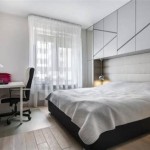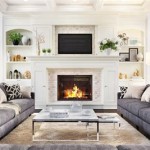Easy Home Decor Ideas to Transform Your Room
Transforming a living space can significantly impact one’s well-being. A well-decorated room fosters comfort, enhances productivity, and reflects personal style. However, many individuals hesitate to embark on home decor projects due to perceived complexities and costs. This need not be the case. Numerous easy home decor ideas exist, allowing individuals to revitalize their rooms without extensive renovations or significant financial investments. This article explores several accessible and effective methods for enhancing room aesthetics.
Repainting for Immediate Impact
One of the most transformative and cost-effective home decor ideas is repainting. A fresh coat of paint can instantly revitalize a room, covering blemishes, updating outdated colors, and creating a new ambiance. The choice of color significantly impacts the overall feeling of the space. Lighter colors, such as whites and pastels, tend to brighten a room, making it appear larger and more open. Conversely, darker colors, such as deep blues and grays, can create a more intimate and cozy atmosphere.
Before commencing the painting process, proper preparation is crucial. This involves cleaning the walls to remove dirt and grime, patching any holes or cracks with spackle, and applying painter's tape to protect trim, windows, and door frames. Selecting the correct paint finish is also important. Matte finishes are ideal for hiding imperfections, while eggshell and satin finishes offer a subtle sheen and are easier to clean. Semi-gloss and gloss finishes are typically used for trim and doors due to their durability and ease of cleaning.
Consider painting an accent wall to add visual interest without committing to an entirely new color scheme for the entire room. An accent wall can serve as a focal point, drawing the eye and adding depth to the space. Experiment with different painting techniques, such as stenciling or sponge painting, to create unique textures and patterns. Remember to allow sufficient drying time between coats to ensure a smooth and durable finish.
Strategic Use of Textiles
Textiles play a crucial role in defining the comfort and aesthetic of a room. Incorporating different textures and patterns through textiles can significantly enhance the overall visual appeal. This includes elements such as curtains, rugs, throw pillows, and blankets. Choosing the right textiles can add warmth, create a sense of luxury, and tie together the different elements of the room.
Curtains are not merely functional window coverings; they are essential decorative elements. Opt for floor-length curtains to create an illusion of height, making the room appear larger. Consider the weight and material of the curtains, as these factors affect the amount of light that enters the room and the level of privacy. Light and airy fabrics, such as linen or voile, allow ample light to filter through, while heavier fabrics, such as velvet or blackout curtains, provide greater privacy and light control.
Rugs provide visual anchors, defining specific areas within a room and adding warmth and texture underfoot. Choosing the right rug size is crucial; a rug that is too small can make the room feel disjointed, while a rug that is too large can overwhelm the space. Ideally, the rug should be large enough to accommodate all the furniture within the seating area. Consider the material and pile height of the rug, as these factors affect its durability and comfort. Natural fibers, such as wool and jute, are durable and add a rustic touch, while synthetic fibers are more stain-resistant and easier to clean.
Throw pillows and blankets offer an opportunity to introduce pops of color and texture. Experiment with different sizes, shapes, and patterns to create a visually interesting arrangement. Mix and match different textures, such as velvet, linen, and faux fur, to add depth and dimension. Arrange throw pillows in an asymmetrical pattern for a more relaxed and casual look. Consider using blankets as decorative throws draped over sofas or chairs to add warmth and visual appeal.
Enhancing Ambiance with Lighting
Lighting is a fundamental element in home decor, influencing the mood and functionality of a room. Effective lighting design incorporates a variety of light sources to create a layered and balanced illumination. This includes ambient lighting, task lighting, and accent lighting, each serving a distinct purpose in enhancing the overall ambiance.
Ambient lighting provides overall illumination to the room, creating a base level of brightness. This can be achieved through ceiling fixtures, such as chandeliers or pendant lights, or through recessed lighting. Choosing the right bulb is crucial; warm white bulbs create a cozy and inviting atmosphere, while cool white bulbs provide a brighter and more energizing light.
Task lighting provides focused illumination for specific tasks, such as reading, writing, or cooking. This can be achieved through table lamps, floor lamps, or under-cabinet lighting. Position task lighting strategically to minimize glare and shadows. Adjustable lamps allow for greater flexibility in directing the light where it is needed most.
Accent lighting highlights specific features or artwork in the room, adding depth and visual interest. This can be achieved through spotlights, track lighting, or wall sconces. Use accent lighting to draw attention to focal points, such as paintings, sculptures, or architectural details. Consider using dimmer switches to adjust the intensity of the lighting, allowing for greater control over the mood and ambiance of the room.
Consider incorporating natural light whenever possible. Keep windows clean and unobstructed to maximize the amount of sunlight that enters the room. Use sheer curtains or blinds to diffuse the light and reduce glare. Strategically placed mirrors can also help to reflect natural light, making the room appear brighter and more spacious.
Personal Touches and Accessories
Personalizing a room with accessories and decorative items adds character and reflects individual style. These elements transform a generic space into a unique and inviting environment. Photographs, artwork, plants, and decorative objects contribute to the overall aesthetic and create a sense of belonging.
Displaying photographs and artwork is a simple yet effective way to personalize a room. Curate a gallery wall with a collection of framed prints, photographs, and artwork that reflect personal interests and experiences. Arrange the frames in a cohesive manner, considering factors such as size, color, and theme. Alternatively, display larger pieces of artwork as focal points on prominent walls.
Incorporating plants into the decor brings life and vibrancy to the room. Plants not only enhance the aesthetic appeal but also improve air quality. Choose plants that thrive in the specific lighting conditions of the room. Low-maintenance options, such as succulents and snake plants, are ideal for individuals with busy lifestyles. Arrange plants in decorative pots and planters to complement the overall decor.
Decorative objects, such as vases, sculptures, and candles, add visual interest and texture to the room. Group objects together on shelves, tables, or mantels to create visually appealing vignettes. Consider the scale and proportion of the objects to ensure a balanced arrangement. Incorporate items that have personal significance or sentimental value to create a more meaningful and personalized space.
Pay attention to details such as hardware and fixtures. Updating cabinet knobs, drawer pulls, and light switch plates can significantly enhance the overall aesthetic of the room. Choose hardware and fixtures that complement the style and color scheme of the decor. Small changes like these can make a big difference in the overall look and feel of the space.
Rearranging Existing Furniture
Sometimes, a simple rearrangement of existing furniture can significantly alter the feel and functionality of a room. This is a cost-effective and effortless method to refresh the space without purchasing new items. Experimenting with different layouts can create new focal points, improve traffic flow, and enhance the overall sense of spaciousness.
Start by identifying the focal point of the room, such as a fireplace, window, or statement piece of furniture. Arrange the furniture around this focal point to create a cohesive and balanced layout. Consider the function of the room when arranging the furniture. In a living room, create a comfortable seating area conducive to conversation and relaxation. In a bedroom, prioritize the placement of the bed to maximize comfort and create a restful atmosphere.
Ensure that there is adequate space for movement and circulation throughout the room. Avoid overcrowding the space with too much furniture, as this can make the room feel cramped and uncomfortable. Leave ample space between furniture pieces to allow for easy passage. Consider the placement of doorways and windows when arranging the furniture to avoid obstructing natural light or creating awkward traffic patterns.
Experiment with different furniture arrangements to find the layout that best suits the needs and preferences. Try floating furniture away from the walls to create a more open and airy feel. Use furniture to define different zones within a room. For example, a bookshelf can be used to separate a living area from a dining area in an open-concept space.
Consider swapping furniture pieces between rooms to create a fresh and updated look. A chair from the living room could be moved to the bedroom, or a table from the entryway could be used as a side table in the living room. This is a simple and cost-effective way to repurpose existing furniture and create a new aesthetic without purchasing anything new.
By incorporating these easy home decor ideas, individuals can transform their rooms into more inviting, functional, and personalized spaces. These methods require minimal effort and investment, making them accessible to a wide range of individuals seeking to enhance their living environments. Through thoughtful planning and creative execution, even the simplest changes can significantly impact the overall aesthetic and ambiance of a room.

Designing And Decorating A Room On Budget Designcafe

60 Easy And Chic Home Decor Ideas To Try From Designers

5 Ways To Refresh Your Space Without Anything New Small Living Room Decor Diy Home On A Budget Easy

100 Diy Room Decor Ideas That Work For Any Bedroom Simple Easy

90 Beautiful Living Room Ideas And Decor For A Timeless Look

Easy Ways To Make Your Home Beautiful And Happy

Home Decor Ideas For Any Household

100 Best Bedroom Ideas Design Inspiration

5 Easter Decor Ideas To Light Up Your Home Designcafe

7 Easy Home Interior Design Ideas That Will Help A Dreamlike Decor Without Hassles Miradorlife







